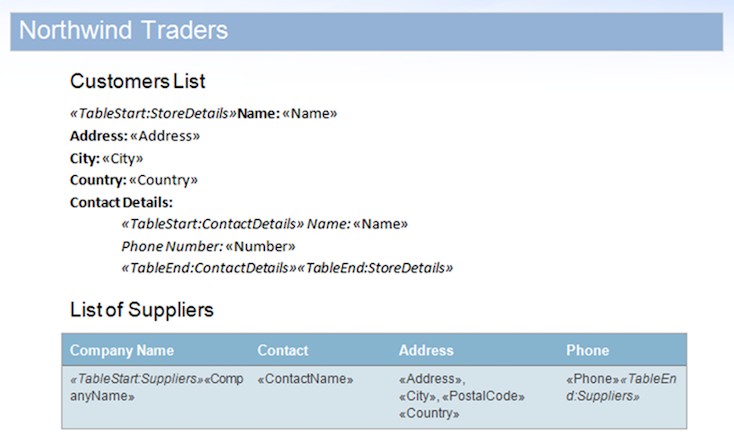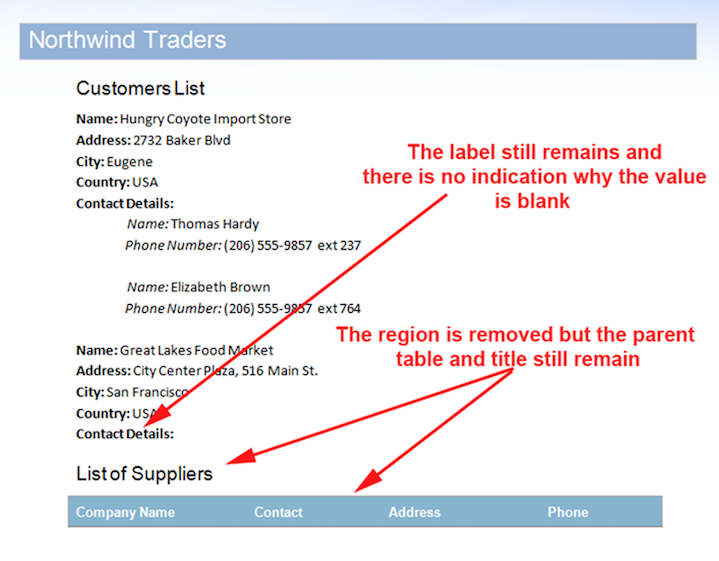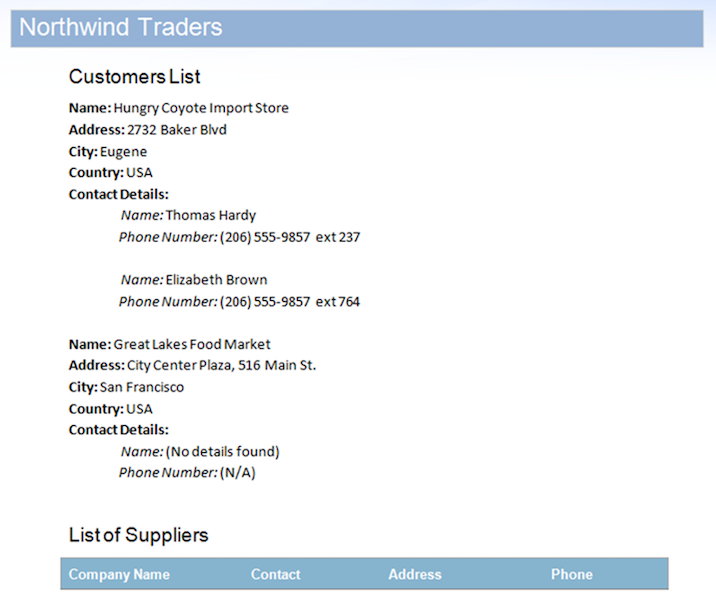Analyzing your prompt, please hold on...
An error occurred while retrieving the results. Please refresh the page and try again.
มีบางสถานการณ์ที่ไม่ต้องการลบพื้นที่ที่ไม่ได้รวมออกจากเอกสารในระหว่างMail Mergeหรือผลลัพธ์ในเอกสารที่ดูไม่สมบูรณ์ มื่อการขาดงานของข้อมูลการป้อนข้อมูลควรจะแสดงให้กับผู้ใช้ในรูปแบบของข้อความแทน.
บทความนี้ไม่มีการอ้างอิงจากเอกสารอ้างอิงหรือแหล่งข้อมูลโปรดช่วยพัฒนาบทความนี้โด ถ้าพื้นที่นี้ไม่ได้ใช้แล้วชื่อและตารางจะยังคงอยู่หลังจากที่ภูมิภาคจะถูกลบออกซึ่งจะมีลักษณ.
บทความนี้จัดเตรียมโซลูชันการกำหนดวิธีการจัดการพื้นที่ที่ไม่ได้ใช้ในเอกสารด้วยตนเอง รหัสฐานสำหรับการทำงานนี้จะถูกจัดมาและสามารถนำกลับมาใช้ได้อย่างง่ายดายในโค.
ตรรกะที่จะนำไปใช้กับแต่ละพื้นที่ถูกกำหนดภายในคลาสที่ใช้อินเทอร์เฟซIFieldMergingCallback ในทำนองเดียวกันตัวจัดการMail Mergeสามารถตั้งค่าเพื่อควบคุมวิธีการรวมแต่ละฟิลด์ตัวจัดการนี้สาม ภายในตัวจัดการนี้คุณสามารถตั้งค่ารหัสเพื่อเปลี่ยนข้อความของภูมิภาคเอาโหนดหรือแถวที่ว่างเปล่าและเซลล์ฯลฯ.
ในตัวอย่างนี้เราจะใช้เอกสารที่แสดงด้านล่าง พื้นที่ที่ซ้อนกันและพื้นที่ที่อยู่ภายในตาราง

เพื่อเป็นการสาธิตอย่างรวดเร็ว เราสามารถเรียกใช้ฐานข้อมูลตัวอย่างบนเอกสารตัวอย่างโดยเปิดใช้งานแฟล็ก MailMergeCleanupOptions.REMOVE_UNUSED_REGIONS คุณสมบัติจะลบภูมิภาคที่ไม่รวมออกจากเอกสารโดยอัตโนมัติระหว่างการ mail merge.
แหล่งข้อมูลประกอบด้วยสองระเบียนสำหรับภูมิภาคStoreDetailsแต่จงใจจะมีข้อมูลใดๆสำหรับเด็กContactDetailsภูมิภาค นอกจากนี้พื้นที่Suppliersไม่มีแถวข้อมูลใดๆเช่นกัน ทำให้พื้นที่ที่ไม่ได้ใช้ยังคงอยู่ในเอกสาร ผลลัพธ์หลังจากการรวมเอกสารกับแหล่งข้อมูลนี้อยู่ด้านล่าง

ดังที่ระบุไว้ในภาพคุณจะเห็นว่าภูมิภาคContactDetailsสำหรับเรกคอร์ดที่สองและSuppliersภูมิภาคถูกลบออกโดยอัตโนมัติโดยเครื่องยนต์Mail Mergeเนื่องจากไม่มีข้อมูล อย่างไรก็ตามมีปัญหาบางอย่างที่ทำให้เอกสารที่ส่งออกนี้ดูไม่สมบูรณ์:
เทคนิคที่ให้ไว้ในบทความนี้แสดงให้เห็นถึงวิธีการใช้ตรรกะแบบกำหนดเองกับแต่ละภูมิภาค.
การแก้ปัญหา
เมื่อต้องการใช้ตรรกะกับแต่ละพื้นที่ที่ไม่ได้ใช้ในเอกสารด้วยตนเองเราใช้ประโยชน์จากคุณลักษณะที่มีอยู่แล้วในAspose.Words.
เครื่องยนต์Mail Mergeให้คุณสมบัติในการลบพื้นที่ที่ไม่ได้ใช้ผ่านธงMailMergeCleanupOptions.RemoveUnusedRegions สามารถปิดใช้งานเพื่อไม่ให้พื้นที่ดังกล่าวถูกแตะต้องในระหว่างmail merge นี้ช่วยให้เราสามารถออกจากพื้นที่ที่ไม่รวมในเอกสารและจัดการกับพวกเขาด้วยตนเองแ.
จากนั้นเราสามารถใช้ประโยชน์จากคุณสมบัติMailMerge.FieldMergingCallbackเป็นวิธีการที่จะใช้ตรรกะที่กำหนดเองของเราเองกับภูมิภาคที่ไม่รวมเหล่านี้ในระหว่างMail Mergeผ่านการใช้คลาสจัดการการใช้อินเตอร์เฟซIFieldMergingCallback.
รหัสนี้ภายในคลาสตัวจัดการเป็นคลาสเดียวที่คุณจะต้องปรับเปลี่ยนเพื่อควบคุมตรรกะที่ใช้กั รหัสอื่นๆในตัวอย่างนี้สามารถนำกลับมาใช้ได้โดยไม่ต้องปรับเปลี่ยนในโครงการใดๆ.
โครงการตัวอย่างนี้แสดงให้เห็นถึงเทคนิคนี้ มันเกี่ยวข้องกับขั้นตอนต่อไปนี้:
รหัส
การใช้งานสำหรับวิธีการExecuteCustomLogicOnEmptyRegionsจะพบด้านล่าง วิธีนี้ยอมรับพารามิเตอร์หลาย:
งคุณ
แสดงวิธีรันลอจิกแบบกำหนดเองบนพื้นที่ที่ไม่ได้ใช้โดยใช้ตัวจัดการที่ระบุ.
งคุณ
กำหนดวิธีที่ใช้ในการจัดการพื้นที่ที่ไม่รวมด้วยตนเอง.
วิธีการนี้เกี่ยวข้องกับการค้นหาพื้นที่ที่ไม่ได้รวมทั้งหมดในเอกสาร วิธีนี้ทำได้โดยใช้วิธีการMailMerge.GetFieldNames เมธอดนี้จะส่งคืนฟิลด์ที่ผสานทั้งหมดในเอกสารรวมถึงเครื่องหมายจุดเริ่มต้นและจุดสิ้นสุดของพื้นที่(แสดงโดยฟิลด์ผสานกับคำนำหน้าTableStartหรือTableEnd).
เมื่อพบฟิลด์TableStartผสานนี้จะถูกเพิ่มเป็นDataTableใหม่ในDataSet รรวมกับระเบียนหลายรายการ)ตารางจะสร้างและเพิ่มก็ต่อเมื่อไม่มีอยู่แล้วในDataSet.
เมื่อพบจุดเริ่มต้นภูมิภาคที่เหมาะสมและเพิ่มลงในฐานข้อมูลแล้ว ฟิลด์ถัดไป (ซึ่งสอดคล้องกับฟิลด์แรกในภูมิภาค) จะถูกเพิ่มลงใน DataTable จำเป็นต้องเพิ่มเฉพาะฟิลด์แรกสำหรับแต่ละฟิลด์ในภูมิภาคที่จะผสานและส่งไปยังตัวจัดการ.
นอกจากนี้เรายังตั้งค่าฟิลด์ของฟิลด์แรกเป็น"FirstField"เพื่อให้ง่ายต่อการใช้ตรรกะกับฟิลด์แรกหรืออื่ โดยรวมนี้มันหมายความว่ามันไม่จำเป็นที่จะยากรหัสชื่อของฟิลด์แรกหรือใช้รหัสพิเศษเพื่อ.
รหัสด้านล่างแสดงให้เห็นถึงวิธีการทำงานของระบบนี้ เอกสารที่แสดงในช่วงเริ่มต้นของบทความนี้จะถูกจดจำด้วยแหล่งข้อมูลเดียวกันแต่คราวนี้.
งคุณ
แสดงวิธีจัดการพื้นที่ที่ไม่รวมหลังจากMail Mergeด้วยโค้ดที่ผู้ใช้กำหนด.
รหัสดำเนินการที่แตกต่างกันตามชื่อของพื้นที่ที่ดึงข้อมูลโดยใช้คุณสมบัติFieldMergingArgs.TableName โปรดทราบว่าขึ้นอยู่กับเอกสารและภูมิภาคของคุณคุณสามารถรหัสตัวจัดการเพื่อเรียกใช้ตรรกะขึ้นอยู่กับแต่ละภูมิภาคหรือรหัสที่ใช้กับทุกพื้นที่ที่ไม่ได้รวมในเอกสารหรือการรวมกันของทั้งสอง.
ตรรกะสำหรับภูมิภาคContactDetailsเกี่ยวข้องกับการเปลี่ยนข้อความของแต่ละฟิลด์ในภูมิภาคContactDetailsด้วยข้อคว ชื่อของแต่ละฟิลด์จะตรงกันภายในตัวจัดการโดยใช้คุณสมบัติFieldMergingArgs.FieldName.
กระบวนการที่คล้ายกันจะถูกนำไปใช้กับภูมิภาคSuppliersด้วยการเพิ่มรหัสพิเศษเพื่อจัดการตารางที่ รหัสจะตรวจสอบว่าภูมิภาคอยู่ภายในตาราง(ตามที่มันอาจจะถูกลบออกแล้ว) หากเป็นเช่นนั้นมันจะลบตารางทั้งหมดออกจากเอกสารรวมทั้งย่อหน้าที่นำหน้าตราบใดที่มีการจัดรูปแบบด้วยรูปแบบหัวเรื่องเช่น"Heading 1".
งคุณ
แสดงวิธีกำหนดลอจิกแบบกำหนดเองในตัวจัดการการดำเนินการIFieldMergingCallbackที่ถูกดำเนินการสำหรับพื้.
ผลของรหัสข้างต้นจะแสดงด้านล่าง รกจะถูกแทนที่ด้วยข้อความที่ให้ข้อมูลและการลบของตารางและส่วนหัวช่วยให้เอกสารที่.

รันในทุกพื้นที่ที่ไม่ได้ใช้แทนที่จะเป็นเพียงภูมิภาคที่เฉพาะเจาะจงโดยการลบการตรวจสอบชื่ ในกรณีนี้หากภูมิภาคใดๆภายในตารางไม่รวมกับข้อมูลใดๆทั้งภูมิภาคและตารางคอนเทนเนอร์.
เราสามารถแทรกโค้ดที่แตกต่างกันในตัวจัดการเพื่อควบคุมวิธีการจัดการภูมิภาคที่ไม่มีกา บทความนี้ไม่มีการอ้างอิงจากเอกสารอ้างอิงหรือแหล่งข้อมูลโปรดช่วยพัฒนาบทความนี้โด ย่อหน้าอื่นๆเหล่านี้จะถูกลบออกเนื่องจากจะยังคงอยู่ในภูมิภาคหลังจากการรวมข้อความขอ.
ข้อความการแทนที่จะถูกผสานลงในฟิลด์แรกโดยการตั้งค่าข้อความที่ระบุไว้ในคุณสมบัติFieldMergingArgs.Text ข้อความจากคุณสมบัตินี้ถูกรวมเข้ากับฟิลด์โดยเครื่องยนต์Mail Merge.
รหัสนี้ใช้เฉพาะฟิลด์แรกในพื้นที่โดยการตรวจสอบคุณสมบัติFieldMergingArgs.FieldValue ค่าฟิลด์ของฟิลด์แรกในพื้นที่ถูกทำเครื่องหมายด้วย"FirstField" นี้ทำให้ตรรกะชนิดนี้ง่ายต่อการใช้ในหลายภูมิภาคเนื่องจากไม่มีรหัสพิเศษเป็นสิ่งจำเป็น.
งคุณ
แสดงวิธีแทนที่พื้นที่ที่ไม่ได้ใช้ด้วยข้อความและลบย่อหน้าพิเศษ.
เอกสารผลลัพธ์หลังจากที่รหัสข้างต้นได้รับการดำเนินการจะแสดงด้านล่าง พื้นที่ที่ไม่ได้ใช้จะถูกแทนที่ด้วยข้อความที่ระบุว่าไม่มีระเบียนที่จะแสดง.

เป็นอีกตัวอย่างหนึ่ง,เราสามารถแทรกรหัสด้านล่างแทนรหัสเดิมจัดการSuppliersRegion. นี้จะแสดงข้อความภายในตารางและผสานเซลล์แทนการเอาตารางออกจากเอกสาร เนื่องจากภูมิภาคอยู่ในตารางที่มีหลายเซลล์,มันดูดีกว่าที่จะมีเซลล์ของตารางรวมกันและข้อ.
งคุณ
แสดงวิธีผสานเซลล์ระดับบนทั้งหมดของพื้นที่ที่ไม่ได้ใช้และแสดงข้อความภายในตาราง.
เอกสารผลลัพธ์หลังจากที่รหัสข้างต้นได้รับการดำเนินการจะแสดงด้านล่าง.

สุดท้าย,เราสามารถเรียกวิธีการExecuteCustomLogicOnEmptyRegionsและระบุชื่อตารางที่ควรจะจัดการภายในวิธีการจัดการข.
งคุณ
แสดงวิธีระบุเฉพาะพื้นที่ContactDetailsที่จะจัดการผ่านคลาสตัวจัดการ.
การโทรเกินพิกัดนี้ด้วยArrayListที่ระบุจะสร้างแหล่งข้อมูลซึ่งมีเฉพาะแถวข้อมูลสำหรับพื้นที่ที่ระบุ ภูมิภาคอื่นที่ไม่ใช่ภูมิภาคContactDetailsจะไม่ถูกจัดการและจะถูกลบออกโดยอัตโนมัติโดยเครื่องยนต์Mail Mergeแทน ผลของการโทรข้างต้นโดยใช้รหัสในตัวจัดการเดิมของเราจะแสดงด้านล่าง

Analyzing your prompt, please hold on...
An error occurred while retrieving the results. Please refresh the page and try again.